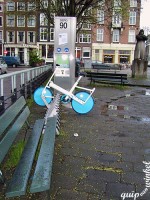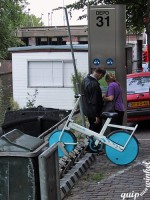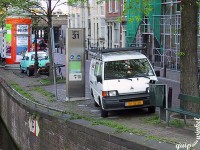In 1967 Luud Schimmelpennink of the Provo party is elected in the Amsterdam City Council. He presents immediately his first White Bicycle plan to the city council. Goal: about two thousand white bicycles driving around in the Amsterdam innercity. But without success.
In 1967 wordt Luud Schimmelpennink van de Provo partij gekozen in de Amsterdamse gemeenteraad. Hij presenteert meteen zijn eerste Witte Fietsen plan aan de raad. Doel: zo’n twee-duizend witte fietsen rondrijdend in de Amsterdame binnenstad. Echter zonder succes.
massive tires and lighting 2002
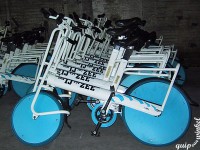
massieve banden en met verlichting 2002
alternative use 1998
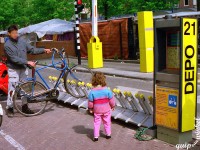
alternatief gebruik 1998
slowly but surely this project is dismantled 2001
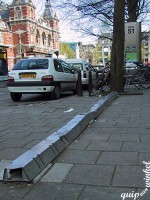

langzaam maar zeker wordt dit projekt geheel ontmanteld 2001
witfiets storage in Halfweg 2002 / witfiets opslag Halfweg 2002
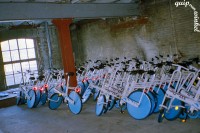


witfiets user / gebruiker 2002
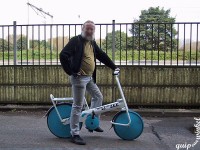
The Amsterdam GVB begins in September 1999, together with Luud Schimmelpennink, again on a White Bicycle-project. As a start with five unmanned depots and about 250 bicycles. It is not a bicycle-rental, but provides just transportation from one depot to the other, like the previous witkar. It has no lock and it is not allowed to leave it somewhere unattended. Furthermore a number of part-time cars will be introduced at the depots, the socalled Depot-Kar.
The design will be a metal pilar for the magnetic card (chipcard) and just beside it a bicycle-rack which will be vandal- and weather proof. The bicycle has massive tires and front and back lights. Everything must be solid and maintenance-free. The eventual aspiration is 45 depots and 750 bicycles, spread out all over the Innercity, Pijp and Oud-West. Costs: 25.000 per depot, in total two million guilders.
Due to the not completely waterproof depots and the frequent disfunctioning of the electronics, problems with software and the necessary permits, corroding parkingforks, the rather heavy peddling and the instability (you must keep both hands on the steering wheel) of the bikes, another White Project bites the dust.
The white bikes are still in use at some small cultural outing like the closing of the sugarbeet factory in Halfweg (just outside Amsterdam) on September 2002.
In september 1999 start het Amsterdamse GVB samen met Luud Schimmelpennink een tweede Witte Fietsen project: te beginnen met 5 onbemande depots en in totaal 250 fietsen. Het is geen fietsverhuur, met gaat enkel van depot A naar depot B, net zoals bij de eerdere witkar. Er zit ook geen fietsslot op en hij mag niet onbeheerd worden achtergelaten. Daarnaast zullen bij de depots enkele deeltijdauto’s worden geïntroduceerd, de zogenoemde Depot-Kar.
Gekozen is voor een zuil voor de betaalpas (chipkaart) en met een fietsen rek ernaast welke vandaal- en weersbestendig worden uitgevoerd. De fiets heeft massieve banden en verlichting. Het geheel moet degelijk en onderhoudsvrij zijn.
Het uiteindelijke streven is 45 depots en 750 fietsen, verspreid over de Binnenstad, de Pijp en Oud-West. Kosten: 25.000 per depot, in totaal 2 miljoen gulden.
Door de niet geheel waterdichte depots met regelmatig uitvallende electronica, problemen met software en met de benodigde vergunningen, corroderende parkeervorken, het tamelijk zwaar trappen en de instabiliteit (je moet beide handen aan het stuur houden) van de fietsen doen ook dit Witte Project de das om.
De witfietsen worden nog wel gebruikt bij kleine culturele uitstapjes zoals bij de sluiting van de suikerbietenfabriek in Halfweg (net buiten Amsterdam) september 2002.
